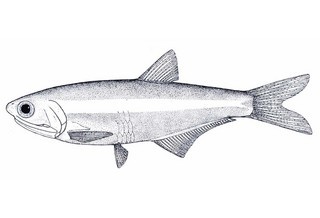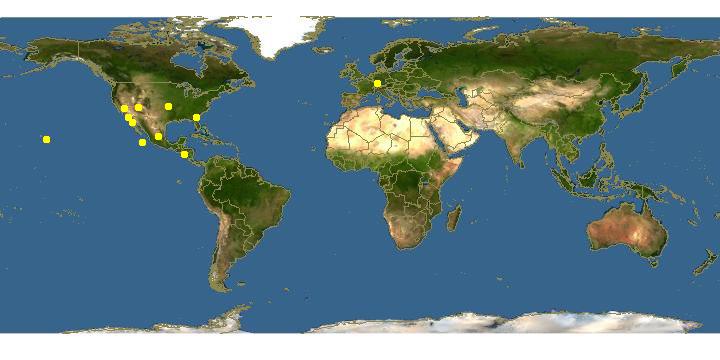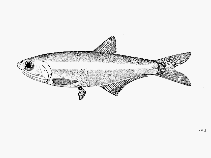
www.fao.org Copyright Michel Lamboeuf · 0
Anchoa compressa |

Click on map for details about points.
|
| Links |
We parsed the following live from the Web into this page. Such content is managed by its original site and not cached on Discover Life. Please send feedback and corrections directly to the source. See original regarding copyrights and terms of use.
- FishBase
|
|
español |
|
|
Overview |
Main identification features
- snout pointed, 1/2-3/4 eye
- deep body
- top jaw - not to edge preopercle, blunt tip
- lower gill rakers 21-24
- anal fin 27-31, origin just before center d
Body moderately deep, compressed; snout pointed, ½-3/4 of eye diameter long; top jaw medium length, not reaching rear of preopercle, tip blunt; no large canine teeth; membrane between gill covers not expanded at rear; third gill arch with raker; 21-24 rakers on lower limb of first gill arch; dorsal fin origin in mid-body; anal fin base long, 27-31 rays, origin just before middle of dorsal fin; pectorals long, reaching base of pelvics.
Bright silver stripe along flank often as wide as eye, not fading in death.
Size: 16.5 cm.
Habitat: marine, coastal pelagic, most commonly found in bays.
Depth: 0-18.5 m.
Point Conception, California to Magdalena Bay, Baja California.
Attributes
Abundance: Common.
Cites: Not listed.
Climate Zone: North Temperate (Californian Province &/or Northern Gulf of California); Northern Subtropical (Cortez Province + Sinaloan Gap).
Depth Range Max: 18.5 m.
Depth Range Min: 0 m.
Diet: phytoplankton; zooplankton; pelagic fish eggs; pelagic fish larvae.
Eastern Pacific Range: Northern limit=36; Southern limit=25; Western limit=-121; Eastern limit=-112; Latitudinal range=11; Longitudinal range=9.
Egg Type: Pelagic; Pelagic larva.
Feeding Group: Planktivore.
FishBase Habitat: Pelagic.
Global Endemism: East Pacific endemic; TEP non-endemic; All species.
Habitat: Water column.
Inshore Offshore: Inshore; Inshore Only.
IUCN Red List: Not evaluated / Listed.
Length Max: 16.5 cm.
Regional Endemism: Tropical Eastern Pacific (TEP) non-endemic; California province, primarily; Continent only; Temperate Eastern Pacific, primarily; Continent; All species.
Residency: Vagrant.
Salinity: Marine; Marine Only.
Water Column Position: Surface; Near Surface; Water column only;
|
|
|
Names | |
|
|
|
Links to other sites | |
|
|
|
References |
- Galván-Magaña, F., Gutiérrez-Sánchez, F., Abitia-Cárdenas, L.A., Rodríguez-Romero, J., 2000., The distribution and affinities of the shore fishes of the Baja California Sur lagoons. In Aquatic Ecosystems of Mexico: Status and Scope. Eds. M. Manuwar, S.G. Lawrence, I.F. Manuwar & D.F. Malley. Ecovision World Monograph Series., Backhuys Publishers:383-398.
- Girard, C., 1858., Fishes. In General report upon zoology fo the several Pacific railrad routes, 1857., U. S. Senate Misc. Doc., (78):1-400.
- Love, M.S., Mecklenburg, C.W., Mecklenburg, T.A., Thorsteinson, L.K., 2005., es of the West Coast and Alaska: a checklist of North Pacific and Artic Ocena species from Baja California to the Alaska-Yukon border., U.S. Department of the Interior, U.S. Geological Survey, Biological Resources Division, 288pp.
|
|
|
Acknowledgements | |
I thank Ashley MacDonald and John Pickering, University of Georgia, for technical support in building this page.
|
|
| Supported by | |
|
Following modified from FishBase
|
Top | See original
http://www.fishbase.org/Summary/speciesSummary.php?genusname=Anchoa&speciesname=compressa ---> http://192.134.151.83/Summary/speciesSummary.php?genusname=Anchoa&speciesname=compressa
http://192.134.151.83/Summary/speciesSummary.php?genusname=Anchoa&speciesname=compressa ---> https://fishbase.mnhn.fr/Summary/speciesSummary.php?genusname=Anchoa&speciesname=compressa
https://fishbase.mnhn.fr/Summary/speciesSummary.php?genusname=Anchoa&speciesname=compressa ---> https://fishbase.mnhn.fr/summary/Anchoa-compressa.html
Anchoa compressa, Deep body anchovy : bait

You can
sponsor
this page
Common name (e.g. trout)
Genus + Species (e.g. Gadus morhua)
-

-
About this page
-
Languages
-
User feedbacks
-
Citation
-
Uploads
-
Related species
-


 Deep body anchovy
Add your observation in
Fish Watcher
Upload your
photos
and
videos
Deep body anchovy
Add your observation in
Fish Watcher
Upload your
photos
and
videos
Pictures
|
Google image
 Anchoa compressa
Anchoa compressa
Picture by
FAO
Teleostei (teleosts) >
Clupeiformes
(Herrings) >
Engraulidae
(Anchovies) > Engraulinae
Etymology:
Anchoa:
Italian ancioa = anchovy (Ref.
45335
)
.
More on author:
Girard
.
Environment: milieu / climate zone / depth range / distribution range
Ecology
Marine; brackish; pelagic-neritic; depth range 0 - 50 m (Ref.
189
). Subtropical; 36°N - 20°N, 121°W - 110°W (Ref.
189
)
Eastern Central Pacific: Morro Bay, California (Ref.
2850
) to Magdalena Bay, Baja California, Mexico.
Size / Weight / Age
Maturity: L
m
?
range ? - ? cm
Max length : 13.3 cm SL male/unsexed; (Ref.
9298
); common length : 10.0 cm SL male/unsexed; (Ref.
9298
); max. reported age: 6 years (Ref.
72482
)
Dorsal
spines
(total): 0;
Anal
spines
: 0;
Anal
soft rays
: 27 - 34. Moderately deep. Snout pointed, about 1/2 to 3/4 eye diameter; maxilla moderate, tip rather blunt, not reaching to hind border of pre-operculum; pseudobranch short, covered by skin; gill cover canals of panamensis-type. Anal fin origin a little before midpoint of dorsal fin base. A bright silver stripe along flank, often as wide as eye, not fading on preservation.
A schooling species most commonly found in bays and inlets (the fourth most abundant fish taken by various gear in Newport Bay, California; its eggs are the most abundant of 7 species sampled, especially in May). The ovarian eggs are spherical. Eggs and larvae are planktonic (Ref.
35602
). Feeds on plankton (Ref.
8593
). Basically filter-feeders, but at times have been observed feeding by selection (Ref.
4930
). Normally used as bait (Ref.
9298
).
Life cycle and mating behavior
Maturity
|
Reproduction
|
Spawning
|
Eggs
|
Fecundity
|
Larvae
Oviparous (Ref.
35602
). Spawn in school (Ref.
205
).
Whitehead, P.J.P., G.J. Nelson and T. Wongratana
, 1988. FAO Species Catalogue. Vol. 7. Clupeoid fishes of the world (Suborder Clupeoidei). An annotated and illustrated catalogue of the herrings, sardines, pilchards, sprats, shads, anchovies and wolf-herrings. FAO Fish. Synop. 125(7/2):305-579. Rome: FAO. (Ref.
189
)
IUCN Red List Status (Ref.
130435
)
Least Concern (LC)
; Date assessed:
18 July 2017
CITES
Not Evaluated
Not Evaluated
Threat to humans
Harmless
Human uses
Bait: usually
FAO - Publication:
search
|
FishSource
|
More information
Countries
FAO areas
Ecosystems
Occurrences
Introductions
Stocks
Ecology
Diet
Food items
Food consumption
Ration
Common names
Synonyms
Metabolism
Predators
Ecotoxicology
Reproduction
Maturity
Spawning
Spawning aggregation
Fecundity
Eggs
Egg development
Age/Size
Growth
Length-weight
Length-length
Length-frequencies
Morphometrics
Morphology
Larvae
Larval dynamics
Recruitment
Abundance
BRUVS
References
Aquaculture
Aquaculture profile
Strains
Genetics
Electrophoreses
Heritability
Diseases
Processing
Nutrients
Mass conversion
Collaborators
Pictures
Stamps, Coins Misc.
Sounds
Ciguatera
Speed
Swim. type
Gill area
Otoliths
Brains
Vision
Tools
E-book
|
Field guide
|
Length-frequency wizard
|
Life-history tool
|
Point map
|
Classification Tree
|
Catch-MSY
|
Special reports
Check for Aquarium maintenance
|
Check for Species Fact Sheets
|
Check for Aquaculture Fact Sheets
Download XML
Summary page
|
Point data
|
Common names
|
Photos
Internet sources
AFORO (otoliths) |
Alien/Invasive Species database
|
Aquatic Commons
|
BHL
|
Cloffa
|
BOLDSystems
|
Websites from users
|
Check FishWatcher
|
CISTI
|
Catalog of Fishes
:
genus
,
species
|
DiscoverLife
|
ECOTOX
| FAO - Publication:
search
|
Faunafri
| Fishipedia |
Fishtrace
| GenBank:
genome
,
nucleotide
|
GloBI
|
Google Books
|
Google Scholar
|
Google
| IGFA World Record |
MitoFish
|
Otolith Atlas of Taiwan Fishes
|
PubMed
| Reef Life Survey | Socotra Atlas |
Tree of Life
| Wikipedia:
Go
,
Search
| World Records Freshwater Fishing |
Zoological Record
Estimates based on models
Preferred temperature (Ref.
123201
): 13.2 - 21.6, mean 17.7 °C (based on 12 cells).
Phylogenetic diversity index (Ref.
82804
): PD
50
= 0.5000 [Uniqueness, from 0.5 = low to 2.0 = high].
Bayesian length-weight: a=0.00513 (0.00232 - 0.01135), b=3.14 (2.96 - 3.32), in cm total length, based on LWR estimates for this Genus-body shape (Ref.
93245
).
Trophic level (Ref.
69278
): 3.4 ±0.45 se; based on food items.
Resilience (Ref.
120179
): High, minimum population doubling time less than 15 months (Preliminary K or Fecundity.).
Fishing Vulnerability (Ref.
59153
): Low vulnerability (10 of 100).
Nutrients (Ref.
124155
): Calcium = 192 [123, 439] mg/100g; Iron = 1.91 [1.08, 3.46] mg/100g; Protein = 17.9 [15.6, 20.6] %; Omega3 = 0.499 [0.277, 0.934] g/100g; Selenium = 17.2 [8.1, 37.9] μg/100g; VitaminA = 20.4 [6.6, 54.1] μg/100g; Zinc = 1.36 [0.94, 2.07] mg/100g (wet weight);
Back to Search
Random Species
Back to Top
Accessed through:
Not available
FishBase mirror site :
localhost
Page last modified by :
mrius-barile
- 20 July 2016
Fatal error
: Uncaught ArgumentCountError: Too few arguments to function checkEcotox(), 1 passed in /var/www/html/summary/speciessummary.php on line 2304 and exactly 3 expected in /var/www/html/includes/speciessummary.lib.php:2579 Stack trace: #0 /var/www/html/summary/speciessummary.php(2304): checkEcotox() #1 {main} thrown in
/var/www/html/includes/speciessummary.lib.php
on line
2579
|
Updated: 2024-05-23 04:40:12 gmt
|